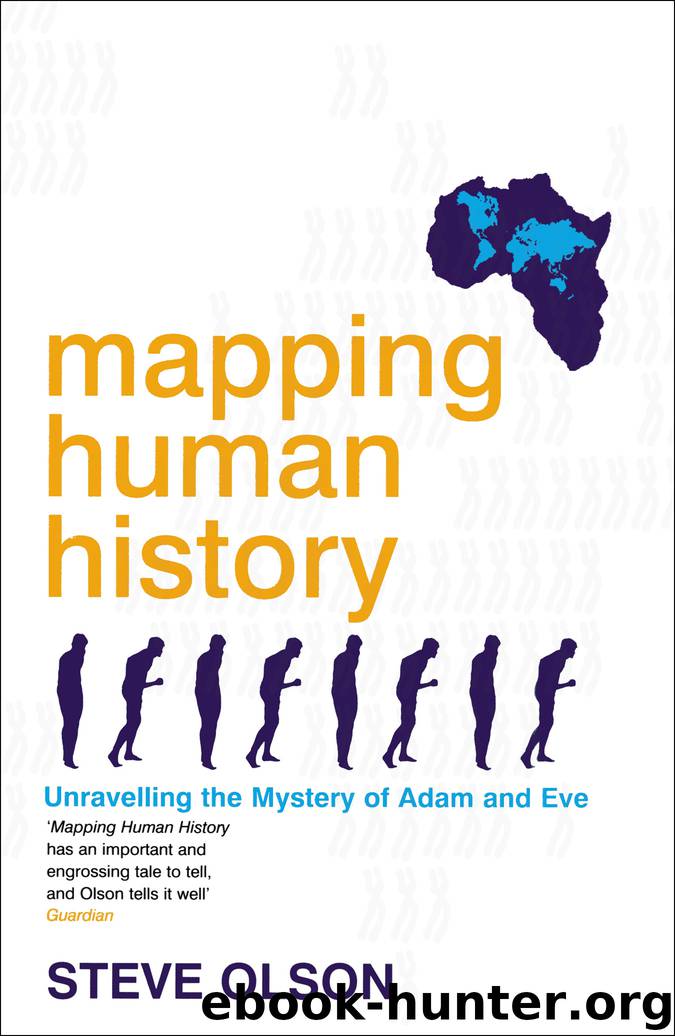Mapping Human History by Steve Olson

Author:Steve Olson
Language: eng
Format: epub
Publisher: Bloomsbury Publishing
Published: 2014-04-06T16:00:00+00:00
Almost all of the world’s 5,000 languages can be sorted into nineteen families. The distributions of these families and of genetic variation bear remarkable similarities, though many of the relationships between genes and languages remain obscure.15
AFRICA
The languages spoken south of the Sahara are diverse, as are the people who live in this part of the world. Yet in 1963, Joseph Greenberg proposed that these languages could be grouped into three broad families. Although his classification originally met with vehement criticism, today almost all linguists agree with it.
The Bushmen of South Africa and their pastoralist cousins the Khoi-Khoi speak what are termed Khoisan languages. These are the only languages in the world that rely heavily on a wide variety of complicated click sounds. At least five kinds of clicks are made with various parts of the tongue, throat, and mouth. These clicks can be spoken on a rising or a falling tone, on an in-breath or an out-breath. They make the Khoisan languages incredibly difficult to learn after childhood. By the same token, listening to a fluent Khoisan speaker is a wonderful experience, since the sounds are so different from those of all other languages.
Some linguists have speculated that these clicks identify the Khoisan languages as the world’s oldest, with the clicks then being lost in the languages that spread out into the rest of the world. This theory corresponds well with the very old mitochondrial and Y haplotypes found in many Bushmen. But another possibility is that the clicks entered the Khoisan languages after they diverged from earlier languages and never spread more widely.
The Khoisan languages have one major anomaly. In Tanzania, more than a thousand miles from the Bushmen and Khoi-Khoi, live two small groups of people, the Hadza and Sandawe, who speak languages that also have many click sounds. Anthropologists do not yet know whether these groups are descended from southern Africans who migrated to eastern Africa or whether they represent the remnants of a Khoisan-speaking people who once lived throughout eastern and southern Africa.
Most of the people of western, central, and southern Africa speak languages belonging to the Niger-Kordofanian family. By far the largest number of languages in this family belong to the Bantu subfamily, which spread from present-day Nigeria starting about 2,500 years ago.
Languages belonging to the third major family in sub-Saharan Africa, the Nilo-Saharan family, are spoken in areas scattered to the north and east of the Niger-Kordofanian languages. Some linguists have suggested that the Nilo-Saharan and Niger-Kordofanian families have enough similarities to be combined into a single family, a grouping that would encompass most of the languages spoken by sub-Saharan Africans.
Download
This site does not store any files on its server. We only index and link to content provided by other sites. Please contact the content providers to delete copyright contents if any and email us, we'll remove relevant links or contents immediately.
The Leavers by Lisa Ko(6461)
Born to Run: by Christopher McDougall(6251)
iGen by Jean M. Twenge(4694)
Sapiens by Yuval Noah Harari(4531)
The Kite Runner by Khaled Hosseini(4416)
Spare by Prince Harry The Duke of Sussex(4188)
Bullshit Jobs by David Graeber(3173)
Livewired by David Eagleman(3116)
Goodbye Paradise(2949)
Never by Ken Follett(2873)
A Dictionary of Sociology by Unknown(2516)
Harry Potter 4 - Harry Potter and The Goblet of Fire by J.K.Rowling(2413)
The Club by A.L. Brooks(2350)
People of the Earth: An Introduction to World Prehistory by Dr. Brian Fagan & Nadia Durrani(2345)
The Social Psychology of Inequality by Unknown(2304)
Machine Learning at Scale with H2O by Gregory Keys | David Whiting(2267)
Harry Potter and the Order of the Phoenix (5) by J.K. Rowling(2224)
0041152001443424520 .pdf by Unknown(2214)
Don't Sleep, There Are Snakes by Daniel L. Everett(2213)
